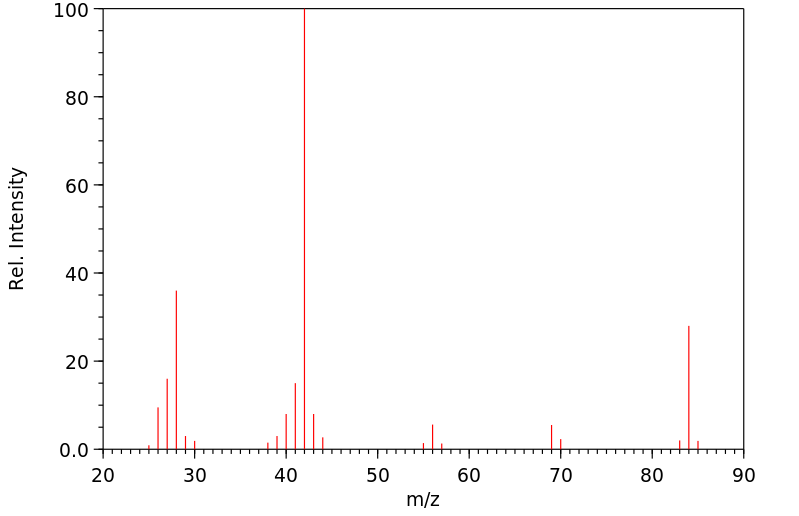1,4-Dihydro-3,6-dimethyl-1,2,4,5-tetrazin | 37454-64-1
中文名称
——
中文别名
——
英文名称
1,4-Dihydro-3,6-dimethyl-1,2,4,5-tetrazin
英文别名
3,6-dimethyl-1,4-dihydro-1,2,4,5-tetrazine
CAS
37454-64-1
化学式
C4H8N4
mdl
——
分子量
112.134
InChiKey
DPHZUYOKHNJDLR-UHFFFAOYSA-N
BEILSTEIN
——
EINECS
——
-
物化性质
-
计算性质
-
ADMET
-
安全信息
-
SDS
-
制备方法与用途
-
上下游信息
-
文献信息
-
表征谱图
-
同类化合物
-
相关功能分类
-
相关结构分类
计算性质
-
辛醇/水分配系数(LogP):0.8
-
重原子数:8
-
可旋转键数:0
-
环数:1.0
-
sp3杂化的碳原子比例:0.5
-
拓扑面积:48.8
-
氢给体数:2
-
氢受体数:2
SDS
反应信息
-
作为反应物:描述:参考文献:名称:3,3- Difluorocyclopropenes的三组分反应,š -Tetrazines,和(苯并)吡啶类摘要:在研究单电子3,3-二氟环丙烯在反电子中的反应性时,发现了一种新的三组分反应,可导致1-α-(吡啶基-2- [1,2,4]三唑基)-2-烷基-乙炔带有s-四嗪的Diels–Alder(IEDDA)环加成–环还原序列。涉及上述反应物和(苯并)吡啶作为第三组分的反应导致在温和条件下以化学计量比的反应物进行复杂的转化,并具有较高的官能团耐受性(苯酚,酰胺,醚,羧酸,酮,和丙烯酸酯)。结果,简单的吡啶以良好的分离产率在α-位选择性地官能化。反应机理包括在s之间稀有的亲氮[4 + 2]-环加成步骤-四嗪和中间体1-羟基吲哚嗪,建议在副产物鉴定后用氘标记追踪。迄今为止,这只是四嗪偏重的亲氮环加成的第三个已知实例。该反应实际上是三组分的,不能有效地逐步进行。DOI:10.1021/acs.joc.0c02292
-
作为产物:描述:参考文献:名称:反式玉米素的光响应和四嗪响应调制摘要:适当设计的笼养激素的光辐射和小有机分子触发能够以高空间和时间分辨率控制和操纵相应的生物过程。已经合成了被硝基苯碳酸酯取代作为光可去除保护基团的笼状反式玉米素和作为四嗪响应基序的反式环辛烯。已实现捕获的反式玉米素分子的平稳释放,允许有针对性地干扰生物过程,包括降解、糖基化和适当酶的识别。DOI:10.1021/acs.joc.2c02601
文献信息
-
Tetrazine Assists Reduction of Water by Phosphines: Application in the Mitsunobu Reaction作者:Alexander V. Polezhaev、Nicholas A. Maciulis、Chun-Hsing Chen、Maren Pink、Richard L. Lord、Kenneth G. CaultonDOI:10.1002/chem.201600913日期:2016.9.19nevertheless suggested as the intermediate in the observed redox reaction. The relationship of this to the Mitsunobu reaction, which absorbs the components of water evolved in the conversion of alcohol and carboxylic acid to ester, with desirable inversion at the alcohol carbon, is discussed. This enables a modified Mitsunobu reaction, with tetrazine replacing EtO2CN=NCO2Et (DEAD), which has the advantage3,6-二取代-1,2,4,5-四嗪与水和PEt 3的反应形成相应的1,4-二氢四嗪和OPEt 3。因此,作为化学计量还原剂的PEt 3还原水,并且所得的两个还原当量用于使四嗪双重氢化。通过密度泛函计算评估了缺电子的四嗪与富电子的PR 3之间的各种可能的初始相互作用,包括电荷转移络合物,结果表明,所有这些能量使得它们在平衡状态下无法光谱检测到,但是其中之一是然而,建议将其作为观察到的氧化还原反应的中间体。这与Mitsunobu反应的关系,Mitsunobu反应吸收了讨论了在醇和羧酸向酯的转化过程中放出的水的各种成分,并希望在醇碳上进行转化。这样就可以进行修饰的Mitsunobu反应,用四嗪代替EtO 2 CN = NCO 2 Et(DEAD),其优点是二氢四嗪可以通过用O 2氧化而再循环为四嗪,而氢化DEAD则不可能。对于这种四嗪版本,无法检测到类似甜菜碱的中间体,但是其质子化形式具有特征,包括X射线结构和NMR光谱。
-
Click to Release: Instantaneous Doxorubicin Elimination upon Tetrazine Ligation作者:Ron M. Versteegen、Raffaella Rossin、Wolter ten Hoeve、Henk M. Janssen、Marc S. RobillardDOI:10.1002/anie.201305969日期:2013.12.23Eliminated without a trace: The fastest click reaction, the highly selective inverse‐electron‐demand Diels–Alder reaction, has been modified to enable selective bioorthogonal release. Thus, the click reaction of a tetrazine with a drug‐bound trans‐cyclooctene caused the instantaneous release of the drug and CO2 (see scheme). One possible application is the chemically triggered release, and thereby
-
First representatives of <i>C</i>-glycosyl 1,2,4,5-tetrazines: synthesis of 3-β-<scp>d</scp>-glucopyranosyl 1,2,4,5-tetrazines and their transformation into 3-β-<scp>d</scp>-glucopyranosyl pyridazines作者:Éva Bokor、Dóra T. Kecskés、Ferenc Gombás、Alexandra Fehér、Eszter Kardos、Akram Dabian、Zsófia Vonza、Eszter Szennyes、László SomsákDOI:10.1039/d2nj03920f日期:——applications e.g. in heterocyclic syntheses and recently in bioorthogonal chemistry. C-Glycopyranosyl tetrazines are unknown in the literature, therefore, we have started to study their synthesis. In this paper ring closing reactions leading to s-tetrazines have been investigated with suitable β-D-glucopyranosyl precursors and the feasible transformations have been identified. In addition, the obtained
-
Gmelin Handbuch der Anorganischen Chemie, Gmelin Handbook: Hg: MVol.B2, 88, page 580 - 581作者:DOI:——日期:——
-
Gmelin Handbuch der Anorganischen Chemie, Gmelin Handbook: Hg: MVol.B1, 14.1, page 345 - 355作者:DOI:——日期:——
表征谱图
-
氢谱1HNMR
-
质谱MS
-
碳谱13CNMR
-
红外IR
-
拉曼Raman
-
峰位数据
-
峰位匹配
-
表征信息
同类化合物
辛基羟乙基咪唑啉
辛基羟乙基咪唑啉
苯丙酸,3,4-二羟基-a-羰基-
肉豆蔻基羟乙基咪唑啉
硬脂酸,氨基乙基乙醇胺酰胺-咪唑啉,羧甲基化钠盐
甲基-(1-甲基-吡咯烷-2-亚基)-胺
甲基(5-甲基-1,2-恶唑-3-基)氨基甲酸酯
油基胺乙基咪唑啉
油基羟乙基咪唑啉
氯代醋酸钠与4,5-二氢-十一烷基-1H-咪唑-1-乙醇和氢氧化钠的反应产物
氯二甲基(1-甲基-1-丙烯基)硅烷
氯-乙酸反应产物与2-庚基-4,5-二氢-1H-咪唑-1-乙醇和氢氧化钠
月桂基羟乙基咪唑啉
恶唑-4-基氨基甲酸叔丁酯
异硬脂基羟乙基咪唑啉
异噁隆
异丙基亚氨基吡咯烷
噻唑-2,4-二胺
噁唑-4-胺
叔-丁基2-氨基-6,7-二氢吡唑并[1,5-A]吡嗪-5(4H)-甲酸基酯
十七碳-2-烯基-4,5-二氢-1H-咪唑-1-乙醇盐酸盐
偶氮引发剂VA-064
依凡达明
二氨基吡唑
乙基3-(乙基氨基)-5-甲基-1,2-恶唑-4-羧酸酯
alpha-(氯甲基)-2-异丙基-5-硝基-2H-咪唑-2-乙醇
alpha,4,4-三甲基-2-十一烷基-2-咪唑啉-1-乙醇
Z-2-(8-十七烯基)-4,5-二氢-1H-咪唑-1-乙醇
N-甲基异噻唑-3-胺盐酸
N-甲基-N-(5-甲基-3-异恶唑基)-乙酰胺
N-甲基-3-氨基吡唑
N-甲基-2-吡咯烷酮肟
N-甲基-1,2-噻唑-3-胺1,1-二氧化物
N-环己基-1,2-噻唑-3-胺1,1-二氧化物
N-叔-丁基-5-甲基-2H-吡唑-3-胺
N-乙基-N-(5-甲基-3-异恶唑基)-乙酰胺
N-乙基-1,2-噻唑-3-胺1,1-二氧化物
N-乙基-1,2,5-恶二唑-3,4-二胺
N-{(E)-[(4-氨基-1,2,5-恶二唑-3-基)氨基]亚甲基}乙酰胺
N-[2-[2-[(E)-十七碳-8-烯基]-4,5-二氢咪唑-1-基]乙基]乙烷-1,2-二胺
N-[2-[2-(13-二十一碳烯-1-基)-4,5-二氢-1H-咪唑-1-基]乙基]乙二胺
N-[2-(4,5-二氢-2-十九烷基-1H-咪唑-1-基)乙基]乙二胺
N-[2-(4,5-二氢-2-十一烷基-1H-咪唑-1-基)乙基]乙二胺
N-[(2Z)-哌嗪-2-亚基]-2,2,2-三氟乙酰肼
N-[(2-甲基苯基)氨基甲硫杂酰]-2-(4-羰基-2-苯基喹唑啉-3(4H)-基)-3-苯基丙酰胺
N-BOC-4-氨基噻唑
N-3-异恶唑氨基甲酸叔丁酯
N-(噻二唑-4-基)氨基甲酸乙酯
N-(5-叔丁基-1H-吡唑-3-基)氨基甲酸甲酯
N-(4,5-二甲基-3-异噁唑)氨基甲酸1,1-二甲基乙酯







